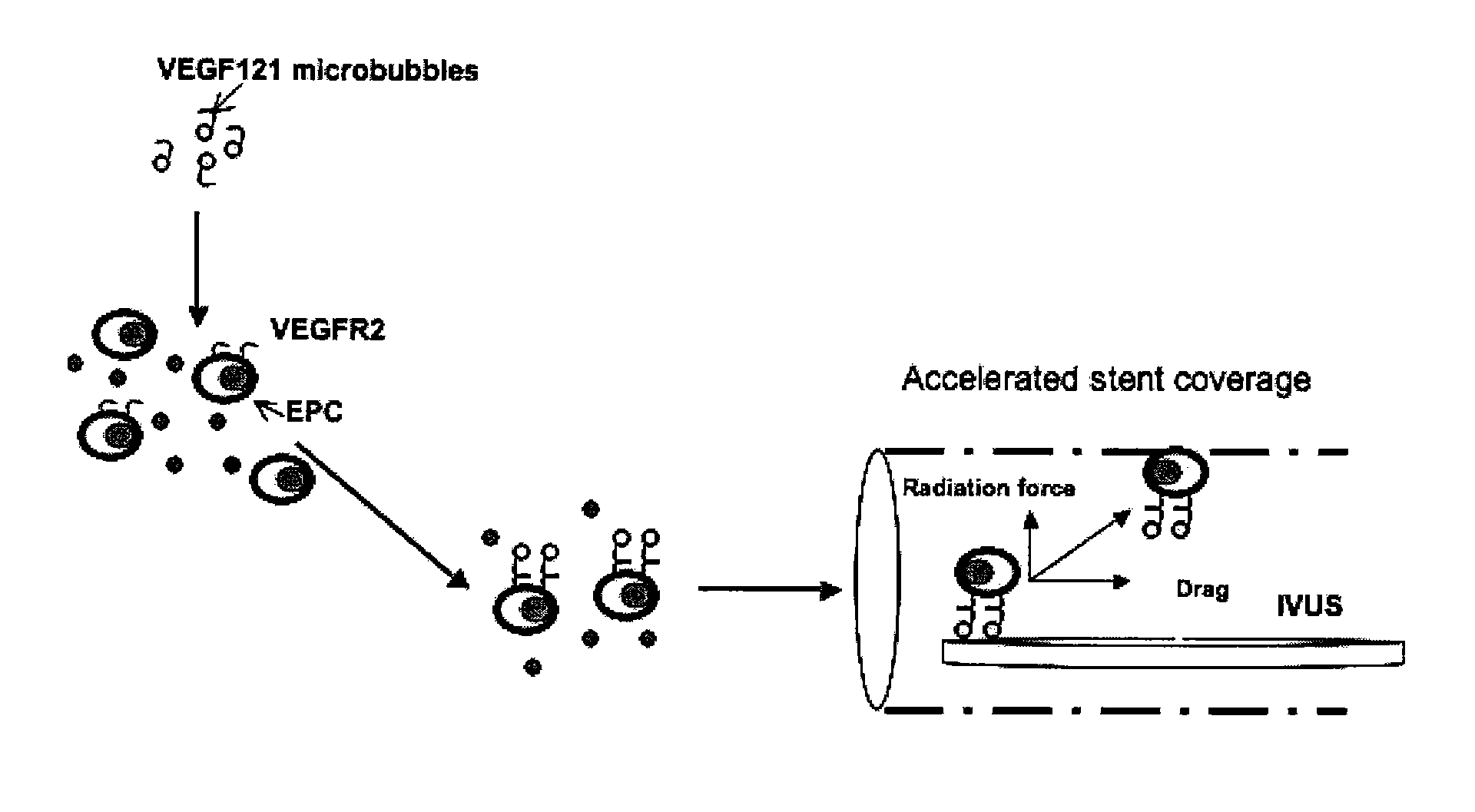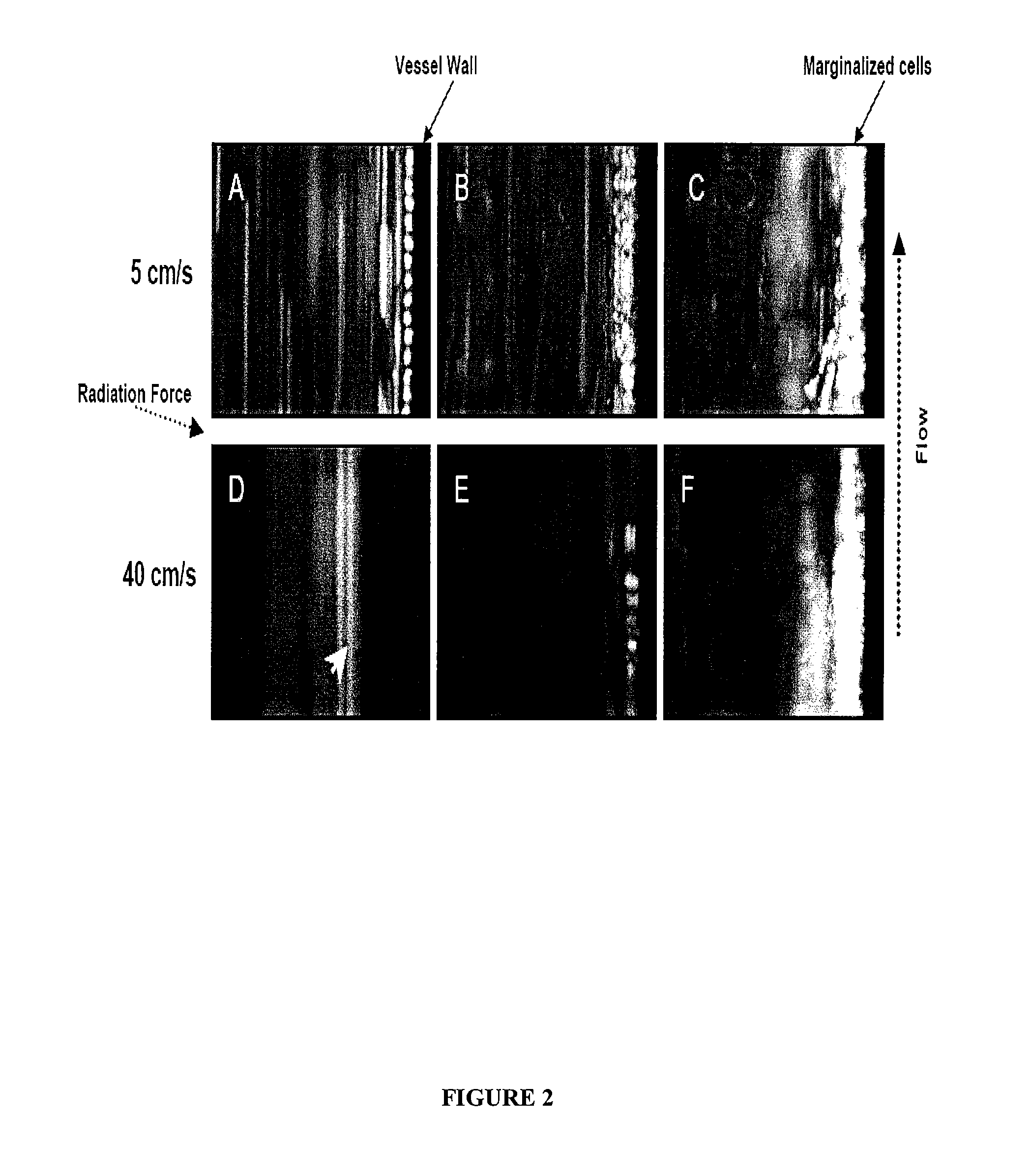Directed cell-based therapy using microbubble tagged cells
a cell-based therapy and microbubble technology, applied in the field of cell-based therapy, can solve the problems of significant delay in the process, significant injury to the arterial wall, loss of endothelial coverage, etc., and achieve the effects of accelerating endothelial cell growth, and increasing the presence of endothelial progenitor cells
- Summary
- Abstract
- Description
- Claims
- Application Information
AI Technical Summary
Benefits of technology
Problems solved by technology
Method used
Image
Examples
example i
In Vitro Blood Vessel Phantom Model
[0306]An in vitro blood vessel phantom was made using a transparent poly(vinyl chloride) (PVC) tube (internal diameter 1 mm) placed in a water tank under the objective of a fluorescence microscope (BX51, Olympus) coupled to a CCD camera (ORCA, Hammamatsu). See, FIG. 1. The 5 MHz ultrasound transducer was immersed in the water nearly perpendicular to the flow direction, with the ultrasound energy focused in the same spot as the optical focus. MSCs were mixed with cationic microbubbles at different ratios (i.e., for example, MSC to microbubbles 1:12, 1:40, and 1:400). Control experiments were performed with MSCs mixed with neutrally charged microbubbles at 1:400 ratio. Mb-MSC complexes (5×104) were diluted in PBS and advanced through the vessel phantom using a syringe pump (Harvard Apparatus) at flow rates resulting in wall shear stress of 0.53 and 4.27 Pa, approximating the coronary wall shear stress during systole and diastole, respectively. The si...
example ii
Cell-Specific Microbubble Complexes and Tissue Imaging
[0307]VEGF 121 has been used for in vivo angiogenesis detection. (Lu et al., 2003). The present experiment tests whether cell-specific microbubble complexes can be used to image tissue in order to monitor healing and tissue regeneration.
[0308]Lipid microbubbles will be prepared from a lipid mixture consisting of distearoyl phosphocholine (PC), biotinylated distearoyl phosphoethanolamine (PE) tethered via polyethylene glycol (PEG), and PEG-stearate, dissolved in chloroform. The dried lipid mixture is re-hydrolyzed using saline and sonicated in the presence of perfluorobutane gas. The biotinylated PE in the bubble composition allows for the attachment of the ligand of interest via a streptavidin bridge. The bubble-cell association will be then tested using rat bone marrow derived EPCs expanded in culture to obtain a uniform cell preparation. Cell-bubble association will be quantified by microscopy by counting the number of microbub...
example iii
Regeneration of Functional Endothelium Tissue
[0314]This example tests whether a cell-therapy improves endothelial coverage in an animal model of vascular injury.
[0315]A rat model of femoral injury is provided using a cutdown approach, wherein a small PE10 cannula is inserted via the femoral artery to the level of the iliacs in Wistar rats. Local vasoconstriction is induced with a high KCl solution. By advancing the catheter up and down a few times, effective de-endothelialization of the femoral segment is created without damage to the media (Lu et el., “A new method to denude the endothelium without damage to media: structural, functional, and biomechanical validation”Am J Physiol Heart Circ Physiol. 286:H1889-H1894 (2004). After the denudation, the cannula is removed and hemostasis obtained. The contralateral femoral is then cannulated using a 34 G microfill needle advanced to the level of the aortic bifurcation. This will serve as the cell injection port.
[0316]Microbubble-cell ass...
PUM
 Login to View More
Login to View More Abstract
Description
Claims
Application Information
 Login to View More
Login to View More - R&D
- Intellectual Property
- Life Sciences
- Materials
- Tech Scout
- Unparalleled Data Quality
- Higher Quality Content
- 60% Fewer Hallucinations
Browse by: Latest US Patents, China's latest patents, Technical Efficacy Thesaurus, Application Domain, Technology Topic, Popular Technical Reports.
© 2025 PatSnap. All rights reserved.Legal|Privacy policy|Modern Slavery Act Transparency Statement|Sitemap|About US| Contact US: help@patsnap.com



